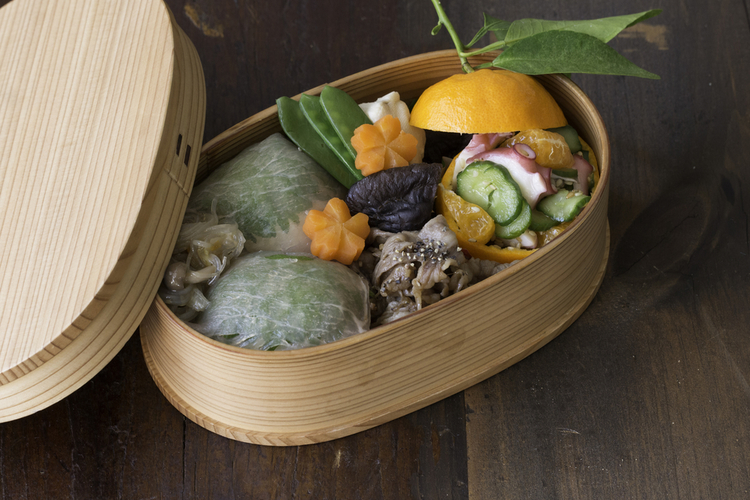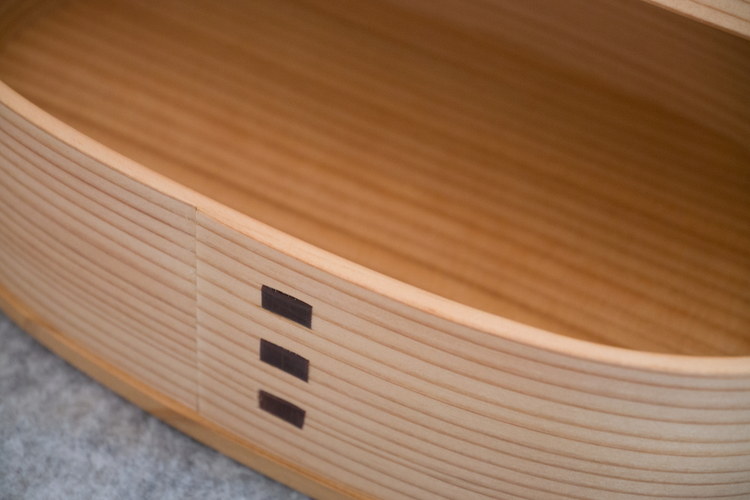“Mage-Wappa” is a traditional craftwork, also called as “Mage-Mono”, which is produced by bending thinly processed wood.
It includes products such as a lunch box, a rice tub, a container with a lid, which has a smooth curve.
Especially, “Odate Mage-Wappa”, produced in Odate-city, Akita prefecture, is famous and is designated, in 1980, as the only national traditional craftwork among “Mage-Mono” in Japan.
“Odate Mage-Wappa” is uniquely made with natural Akita cedars grown near the Yoneshiro-gawa River flowing in the north of Akita.
In Akita, it snows a lot, which slows the growth of trees to narrow the width of annual rings and grow up straight. This brings trees the strength and durability.
Also its gentle tree scent is very attractive.
Natural Akita cedars is one of the three most beautiful forests in Japan together with Kiso Hinoki and Aomori Hiba.
However, in 2012, it was decided to ban felling of natural Akita cedars from the perspective of natural conservation, and in 2013, it was officially banned.
“Odate Mage-Wappa” is now produced from the limited materials on stock, which makes its value higher.

History of Odate Mage-Wappa
It is said that producing of “Odate Mage-Wappa” began in Akita about 1,300 years ago in the Nara period.
It was the beginning that woodcutters created vessels by bending a cedar plate.
In Odate Folk Museum, “Odate Mage-Wappa”, made in the middle of the Heian period(794-1185), is on display.
Later in the Edo period(1603-1867), “Mage-Wappa” became established as an industry.
At that time, Yoshinobu Satake, the lord of Odate-jo Castle, had an idea that creating products made with Akita cedars could solve poverty in his territory caused by cold weather and flood.
Then, he lighted on “Mage-Wappa”, which farmers created for their side job, and ordered lower-class samurai to create it as their side.
The beauty of Akita cedars and delicate techniques made the products popular at once.
Later, it became available in Yamagata, Niigata, Kanto area, which spread the brand of “Odate Mage-Wappa” widely.
In the peak period in the early Meiji period(1867-1912), its manufacturing developed to 30 companies and 400 people.
Now its number declined to 8 companies and 63 people, but its traditional techniques have been succeeded by excellent craftsmen.
In 1998, a sake bottle (product name is TOKKURI) created by Kurikyu, “Odate Mage-Wappa” maker, received the Good Design Award.
Recently, “Mage-Wappa” lunch box has again attracted notice by its warm and sophisticated design with the influences of social media.

How to Create Odate Mage-Wappa
“Odate Mage-Wappa” is produced from many processes.
Including the stage of drying wood martials, it takes more than a year.
Now, let’s walk through each process.
1. Cutting off the parts
Cut off straight-grained wooden board cut vertically toward an annual ring from dried cedar logs.
2. Hagitori (Stripping)
Process the edges thinly to the equal thickness by a plane.
3. Boiling
Boil it in 80-degree water to soften the entire board.
4. Bending
Wind a boiled board round a mold to bend it gradually by hand.
5. Drying
Remove from the mold and dry it for 7 to 10 days to fix the curve of a board.
6. Gluing
After “Tsuma Dori”, which refers to shaving the edges of a board by a knife, put glue for wood, fix it for a day and dry it.
7. Sakura-gawa Toji (Cherry bark Binding)
Put soaked cherry bark on the glued parts by “Medoshi-Kiri” to bind, which is called “Kaba-Nui”.
8. Setting a bottom
Assemble by techniques called “Mage-Wa Gasane”, “Hachi-maki Kake”, “Obi Kake” and “Kasane Awase” and set a bottom plate called “Hira Zoko”, “Age Zoko”, and “Shakuri Zoko”.
9. Finishing
Finish it smooth entirely by manual filing.
The process of “Hagitori”, referring to shaving the edges to the equal thickness by a plane when boards are bound, is regarded as the most difficult process which only experienced craftsmen can do.
“Odate Mage-Wappa” defines precisely its materials and techniques.
Above all, all processes should be done manually.

Outstanding Practicality to Recognize
For a long time, miso, soy sauce and sake have been produced in cedar-made barrels.
Wood breathes and keeps fixed humidity, which can protect tastes of food inside.
This is why you put cooked rice to a wood tub.
Wood absorbs extra moisture from cooked rice and prevent it from drying out.
This feature can keep cooked rice for long.
Moreover, cedars is said to have bactericidal effect.
It means that “Mage-Wappa” lunch box is very practical.
In addition, its wooden smooth curve fits in hand and you can feel its natural warmth.
“Mage-Wappa” is, thus, the craftwork representing Japan, with practicality and charm.
How to Maintain Lunch box
You may feel difficult to treat and maintain wooden products.
It is essential for maintenance to wash with lukewarm water as soon as possible after you use it.
You don’t use dishwashing liquid for it.
After washing, dry it well.
With some tips, it is not that hard to maintain your wooden products.

Modern Craftsmen
“Odate Mage-Wappa” has also been suffering from aging and lack of successor among the entire traditional industry.
However, some of young resources who are attracted to the beauty of traditional craftwork and manufacturing itself choose a craftsman as their career these days.
To promote its trend, the Traditional Crafts Industry Promotion Association conducts examination to qualify a successful applicant as “Traditional Craftsman”, which is a part of activities to improve the craftsmen’s status and preserve traditional crafts industry.
Currently, 17 people have qualified as Traditional Craftsman.
Moreover, Odate-city established “Odate Mage-Wappa” Cooperative (http://odate-magewappa.com/) in 1979.
8 manufacturing companies with craftsmen join it to develop their promoting activities such as craftwork producing, selling and participating to various events.
“ Odate Mage-Wappa” Cooperative Participating Companies
〒017-0012 Ieushiro 29-15, Shakanai, Odate
Tel. +81-186-48-7700 (Japanese Only)
〒017-0843 38 Nakamachi, Odate
Tel. +81-186-42-0514 (Japanese Only)
〒017-0044 Onari-cho 2-15-28, Odate
Tel. +81-186-42-6123
>> Sasaki Mage-Mono Kogei
〒017-0045 Nakamichi 3-1-79
Tel. +81-186-42-6875
〒017-0803 Higashidai 655-1, Odate
Tel. +81-186-42-5523
>> Kushima Mage-Mono Kogei
〒017-3501 Oyanagi 88, Iwase, Odate
Tel. +81-186-54-2183
>> Takada Shikki Kogei
〒018-5601 Junisho 2-15, Odate
Tel. +81-186-52-2564
〒017-0023 Iwanoshita 8-1, Azuma, Odate
Tel. +81-186-59-7771
“Odate Mage-Wappa Taiken Kobou (Experience Workshop)” is popular among tourists.
You can experience of creating a bread plate or a lunch box.
Omachi 70, Odate, Akita
Opening hours 9am – 5pm
Tel. +81-186-42-7502
It must be special to have lunch with your handmade lunch box.
Why don’t you try creating real “Mage-Wappa” in the traditional place, Odate in Akita?
Charm of traditional craftworks rooted in one area for long time may be enriched by using it with knowledge about its local natural features and history.
Now the new movement has already begun to grow Akita cedars in a planned way for future craftsmen 100 or 200 years later.
Let’s give your attention to see how “Odate Mage-Wappa” develops with succeeding its tradition.




